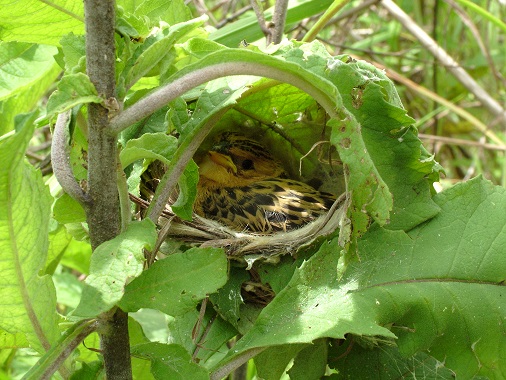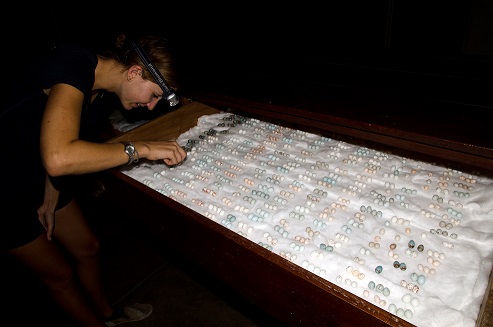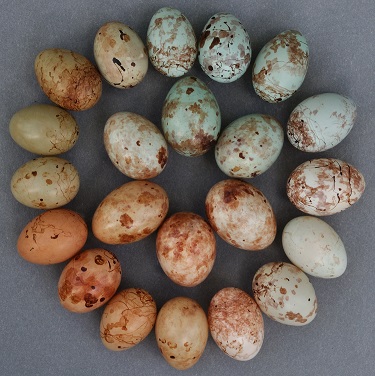Some of the fascinating research on brood parasitism discussed in last month’s Croonian lecture by Professor Nick Davies FRS has been published in Proceedings B this week

Some of the fascinating research on brood parasitism discussed in last month’s Croonian lecture, by Professor Nick Davies, FRS has been published in Proceedings B this week. We asked two of the authors, Eleanor Caves and Dr Claire Spottiswoode to tell us a little bit more about this study.
How do cuckoos parasitize other birds, and what effects can this have on the individual hosts and their breeding success?

Cuckoo finch chick in the nest of a red-faced cisticola
Cuckoos – and other brood-parasitic birds – lay their eggs in the nest of a host bird of a different species, to avoid paying the costs of rearing their own young. Parasites often need to rely on trickery to fool host parents into accepting their egg and then chick as one of their own, since it pays a host to reject the impostor if they can detect that they have been parasitised. A very common form of such trickery is egg mimicry: many brood-parasitic birds lay eggs that beautifully match host eggs in appearance, sometimes so well that we ourselves need to take great care to distinguish them in the field.
When it hatches, the parasitic chick often benefits from getting rid of any competition for food, with the end result that host parents spend significant time and effort tending a chick that isn’t their own. Successful parasitism by such so-called ‘virulent’ species of brood parasite means that host parents produce no young of their own that year.
What are egg ‘signatures’, and how do they defend the hosts against parasitism by cuckoos?
Egg ‘signatures’ are an advanced form of defence against egg mimicry by cuckoos: the more distinctive-looking the eggs of each individual female in the host population, the harder they are for a parasite to mimic. A female bird will always lay the same type of egg within her lifetime but crucially, if every host female looks a bit different, then cuckoos can’t fool everyone all of the time. In some host species this has driven the evolution of an astonishing diversity of egg colours and patterns between different females, like the clutches of eggs to the right which all belong to the same species.
We wanted to test whether the evolutionary arms race between cuckoos and their hosts has further escalated to make signatures even harder to forge. Specifically, we tested the hypothesis that brood parasitism has driven hosts to evolve egg signatures composed of unpredictable combinations of different egg traits such as colour and pattern. This makes egg signatures even harder to forge by further increasing the variation between different host females.
How did you quantify phenotypic egg traits to measure these signatures? And what exactly did you find?

Eleanor Caves working on the egg collection
Egg signatures involve both colour and pattern, so we had to measure each of these different aspects of egg appearance. Importantly, however, bird vision differs from human vision in several respects – for example, birds can see ultra-violet colours that are invisble to us – so we need to use instruments to measure egg appearance objectively, and then use models to estimate how a bird might actually sense that visual information, here with the expert help of our collaborator Dr Martin Stevens at Exeter University. We used various methods to measure colour, pattern and brightness, and then with the help of another of our collaborators, Dr Ed Iversen calculated the entropy in the eggs’ appearance that arises from all these different traits. Entropy in this case is a measure of the variability, or ‘disorder’ in a set of traits: the higher the entropy, the greater their disorder or unpredictability from individual to individual.
We found that parasitized species do, on average, show higher entropy than related unparasitized species, making it easier for a host female to recognise a cuckoo’s egg as not one of her own. Our analysis implies that species victimised by brood parasites have indeed evolved to better defend themselves by arranging the various attributes of their ‘signatures’ into unpredictable combinations.
To what effect can cuckoos mimic the egg signatures of their hosts, and how successful is this?
We know from previous work that cuckoos have a hard time mimicking egg signatures. First, a cuckoo species needs to evolve the ability to lay a range of different egg forgeries. Cuckoo finches give us an extreme example: in the photo to the right, the eggs in the outside circle are eggs of a common host, the tawny-flanked prinia, and those in the middle are cuckoo finch eggs that mimic them, all laid by different females. You can see that prinias have evolved a tremendous diversity of signatures varying in both background colour and pattern, and that cuckoo finches have evolved a plausible range of forgeries.

Signatures and forgeries – Cuckoo finch eggs centre, prinia eggs outside
Even if a cuckoo finch can lay a good forgery, curiously, they don’t matches it up against the right signature. Instead, cuckoo finches seem to distribute their eggs haphazardly among nests of different prinia females. Perhaps they strike it lucky often enough for this to be a good enough strategy!
This means that signatures are a really good defence against parasitism, since they reduce the chances that a parasitic egg will be a good match to any given host clutch. This suggests that evolutionary arms races between brood parasites and their hosts can escalate to ever greater complexity: we know that as soon as parasites evolve a deceptive adaptation, such as egg mimicry, hosts are under selection to evolve counter-adaptations such as distinctive egg signatures. What this study shows is that hosts can further escalate their defences by increasing the unpredictability of their egg signatures, and so help to foil parasitic forgeries.
What are you investigating now?
Thanks to lots of field experiments done by many other research teams as well as ourselves, we now know quite a bit about the adaptive function of egg signatures. But we know remarkably little about how they are produced, and how this might affect the variation that natural selection can shape among birds’ nests concealed in the long grass of Zambia. Claire and her collaborators are especially interested in the genetic basis of both signatures and forgeries, and one day would love to know how the shell gland in the birds’ oviducts – the organ where colour and pattern are laid down on the blank canvas of a white eggshell – produces such amazing artwork.
For more information about ongoing research on cuckoos, cuckoo finches and other African brood parasites, please see www.africancuckoos.com.
